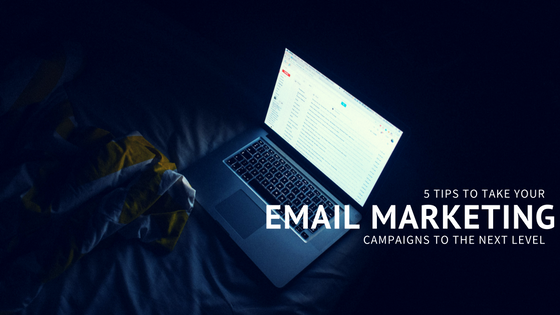
5 tips to take your email marketing campaigns to the next level
By Team EtchRock in All,EtchRock,Inbound Marketing
- 5 ways to boost your post-event engagement - June 22, 2017
- 7 ways to grow your email database - June 15, 2017
- 5 ways to increase slowing ticket sales - May 29, 2017
Taking your email marketing campaigns to the next level
Email marketing is one of the most important tools in any event marketer’s toolkit. Why? Because in marketing terms, it is ‘permission based’. This means that an individual has given us permission to get in contact with them through whatever medium we first communicated. This goes without mentioning that email is 40 times more effective at acquiring a new customer than Facebook or Twitter according to McKinsey.
Instead of trying to lure them with Google ads or other methods, they have voluntarily offered their email address to you as means to engage with your brand. You now need to make good on your promise and deliver the best campaigns possible for your customers.
In this article, we look at 5 ways that you can take your email marketing campaigns to the next level.
Segment your list
If you haven’t segmented your email list already, this should be top of your things to do. By doing so, you will be able to create more personalized and email campaigns based on the specific audience that you are targeting. The guys over at Optinmonster wrote a great article on 50 different ways to segment your list if you’re stuck for ideas.
If you’re just getting started with email segmentation, the best place to start would be to segment your subscriber list into two categories. Either purchased a ticket for your event or not purchased a ticket. From here, you can start the process of developing custom campaigns for each audience, as the messaging will be very different.
For those who haven’t yet purchased a ticket for your event, you should focus on the USP’s of your event, what makes it stand out from the crowd and potentially discounts for first-time buyers. The goal here is to get people to purchase their first ticket. Once they completed that process, you can then move them over into the ‘bought a ticket’ segment.
For the seasoned racers, you will want to focus on ‘content’ based campaigns that are a reflection of their race experience. Photos of the participants, video content from the race and any other ‘sharable’ material are what you want to target this segment with. This content can then be used to pull in a new group of potential customers for your next event.
Have a goal
Leading on from the previous point, your emails need to have a specific goal in mind. Once you’ve segmented your list and know whom you are talking to, you now need to decide why you are actually contacting them. Just sending email because ‘it’s something that you think you should be doing’ is never a good idea. Consumers are savvy to marketing messages nowadays and will unsubscribe if you aren’t providing value.
Ask yourself these following questions.
-Are you actually willing to invest time into email marketing and how will it fit in with your overall marketing strategy?
-In your campaigns, what do you want your customers to know you for? Having just one or two purposes for email isn’t necessarily a bad thing. Do you want to focus on discounts? Maybe race content or the latest event news? If you stick to the same script, customers come to know what to expect from you and in turn, that anticipation can drive greater open rates.
-How will it actually impact your business and do you have the tools to evaluate your campaigns? Are you looking to boost your ticket sales, can you measure clicks from email? If you’re looking to boost your brand awareness, how will you quantify this?
-Why do you your customers need to receive your emails? If you aren’t presenting something new, is it really worth the effort?
Having specific goals in mind will help focus your strategy and ensure your subscribers get a solid outcome from reading them – a key aspect of building a loyal and engaged list.
Getting people on the list
So you have your goals sorted, you’re ready to segment your database and you’re ready to go. But if you haven’t got the bulk numbers in your database, then what’s the point?
You need a sound strategy in place to get people to actually subscribe to your list; here are a couple ideas to get you started:
-Create a landing page that is designed to capture visitor’s data. Here’s a guide on critical elements of a landing page to help you out.
-Add a page to your website that demonstrates to visitors the value of them signing up to your mailing list.
-Run social media competitions that capture data. Sites like ViralSweep are great for this.
-When you sell a ticket, ask if the buyer wants to ‘opt in’ for further communication in the future.
-Offer a discount code for your race, where to receive it, a customer must exchange their email address.
Growing your list in itself is a whole different set of strategies that you will need to learn and experiment with. But once you learn what works for you, growing and engaging with your mailing list will dictate what you do going forward.
Subject matters
It’s easy to think that when it comes to email marketing, the bulk of your attention should go on creating the ‘content’ side. Whilst that is true, the subject line is an element that can’t be overlooked.
According to Convince & Convert, 33% of email recipients decide whether or not to open an email based on subject line alone. This is why it’s so important to craft subject lines that are compelling enough to get people to click through.
There are huge amounts of posts that you can read about how to improve your subject lines on the internet, but here’s a few for you to get started:
-Use the recipient’s name in the subject line. For example, ‘Happy Birthday John, we’ve got a gift for you’.
-Use your event name as the sender. Nothing is worse than getting an email from noreply@blahblahblah.com
-Tell them what’s in the email. For example, ‘Your 20% race discount is waiting for you’.
-Create a sense of urgency. For example, ‘20% off ticket prices today only’.
There is no exact science to creating the perfect subject line, lots of it will come from trial and error and knowing your target audience. Don’t be afraid to experiment! Here is a great infographic from Litmus about how to write the perfect subject line.

Optimize for mobile
You may think this is obvious, but you would be surprised at the amount of event organisers who send an email that looks terrible on mobile. According to Campaign Monitor, 53% of all emails are opened on mobile devices, so if your delivery platform isn’t up to scratch, then you’re in trouble.
If you find yourself looking for a new email client to engage with your participants, make sure you do your research first. The big players like Campaign Monitor and MailChimp come with great functionality and are certainly mobile ready, but they also cost the most too. But have no fear, there are plenty of other options out there, just make sure they are optimized for mobile and have the ability to segment your email list.


